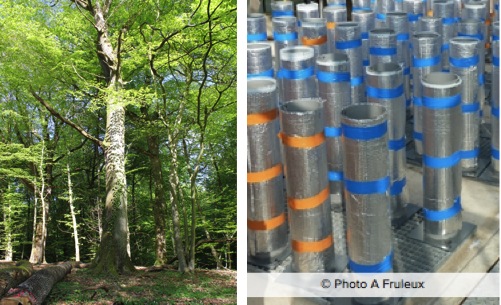Tree Species Interactions under Soil Drought Conditions
Responsable scientifique: Damien Bonal (UMR 1137 Ecologie et Ecophysiologie Forestières — EEF)
Partenaires Labex : M. Schaub (Forest, Snow and Landscape Research — WSL, Switzerland)
Collaborations :
MB. Bogeat-Triboulot, N. Angeli, D. Epron, A. Fruleux (PhD student) — EEF
B. Moser, A. Gessler, L. Schönbeck (PhD student) — WSL
______________________________________________________________________________
Contexte — Des événements climatiques extrêmes induits par les changements climatiques auront des conséquences majeures sur le fonctionnement des écosystèmes forestiers et les services qu’ils rendent. Par ailleurs, il a été démontré qu’une plus forte biodiversité peut favoriser la productivité des écosystèmes forestiers et leur résistance à des agresseurs. De plus, en fonction des conditions environnementales locales et de la composition en espèces des peuplements, les forêts mélangées peuvent, mais ce n’est pas systématique, être plus résistantes à la sécheresse que les forêts pures.
Objectifs — Dans ce projet, nous proposons de renforcer la collaboration entre WSL et INRA en mettant en place le cadre nécessaire à une collaboration sur le long-terme entre WSL, INRA et l’Université de Lorraine sur l’écophysiologie et l’écologie forestières, et plus spécifiquement sur les interactions entre espèces d’arbre en conditions de sécheresse. L’objectif principal est de caractériser la dynamique de prélèvement de l’eau par les racines et les patrons d’allocation des ressources dans les compartiments de jeunes plants élevés en serre et soumis à différents niveaux d’interaction spécifique et de disponibilité en eau (sec / humide).
Démarche — Afin de comprendre les mécanismes à l’origine des effets des interactions observés entre espèces, nous caractériserons l’allocation en biomasse dans les compartiments aériens et souterrains, l’activité photosynthétique, et l’efficience d’utilisation de l’eau de jeunes plants de pin et de chêne élevés en 2016 dans des mésocosmes sous conditions environnementales contrôlées (serres dites « CO2 » à INRA Nancy). Nous appliquerons une expérimentation de double marquage isotopique (13C dans CO2 de l’air et 2H dans l’eau) afin de comprendre la capacité des arbres à répartir les sucres photosynthétiques vers les différents compartiments de l’arbre et à explorer des zones particulières du sol quand ils sont soumis à des niveaux distincts de disponibilité en eau (sec / humide) et d’interactions avec d’autres espèces. En complément de cette expérimentation à Nancy, l’allocation en carbone (marquage 13C) dans les différents compartiments de l’arbre en fonction d’un gradient de disponibilité en eau sera étudiée dans une expérimentation conduite au WSL.
Résultats et impacts attendus — Ce type d’expérimentation en conditions contrôlées est essentiel afin de comprendre les mécanismes physiologiques à l’origine des effets de diversité observés dans les peuplements forestiers. Ce travail constituera une base solide pour l’étape suivante de cette collaboration, qui consistera à mettre en place un projet commun ANR-SNF afin de s’intéresser à ces mécanismes dans des peuplements matures en Suisse et en France.




